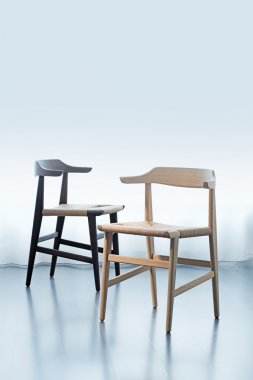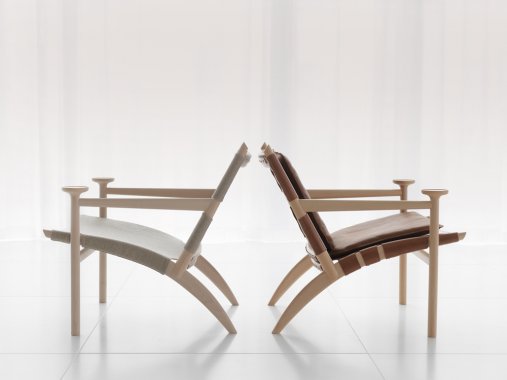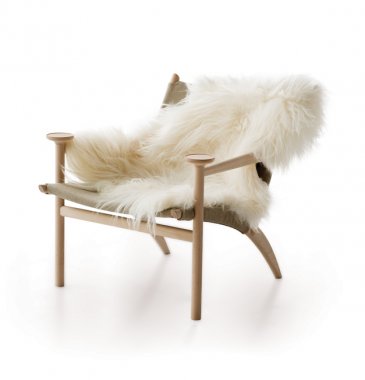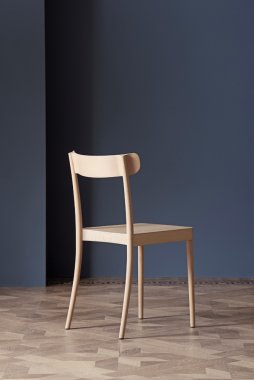Sweden: The Extraordinary In the Ordinary
Sweden: The Extraordinary In the Ordinary
“It’s a very Swedish thing,” designer David Ericsson says of the egalitarian streak that runs through the national character. “For me, it’s not to say that I’m better than you. We’re all equal.” At the same time, he adds, each of us is unique. “We’re all different people. We have different goals, need different kinds of things.”
This humanist view is eloquently expressed in Ericsson’s wood furniture. Since emerging on the interior design scene about 12 years ago, the 40-year-old has earned a reputation for stylish ingenuity, particularly in his chairs, which grace restaurants, hotels, offices, schools, and residences around the world. Designed with beauty, function, and sustainability in mind, they’re meant to serve, to enhance our comfort and pleasure at home and in public. “I love to see people using my furniture,” Ericsson says. “Sitting in it, maybe enjoying it. Touching it, discovering things.”
Take Petite, his version of a classic café chair. Spare and sturdy in bent and laminated beech, it’s an object that wants to highlight the environment it’s in, let the space where people gather shine. It doesn’t shout for attention, yet up close, we see its individuality: the elegant joints and light touches of curvature that underscore purity of line. A practical seat, it’s moderately priced, stackable, and weighs just over 5 pounds.
“I had this idea to make the world’s lightest wooden chair that stacks. I don’t know if it is, but let me know if you find any lighter,” Ericsson says with a smile, speaking via FaceTime from the house in Stockholm that he shares with his wife, Sara (she designs communication systems for social services), and their two kids. He’s in his basement studio, surrounded by sketches and furniture parts.
It’s a relaxed, unglamorous setting for a rising design star. In 2018, Petite took first prize for Sweden in a Scandinavian competition for best sustainable chair, and also won Ericsson Designer of the Year honors from Form, the magazine of Nordic architecture and design. “It’s nice to have recognition for your work,” he allows. “And it's just an ordinary chair, in a way.”
If there’s a down-to-earth modesty about Ericsson, that is also a sort of Swedish thing, one historically reflected in the creative simplicity of its furniture – the understated aesthetic, the feel for material, the emphasis on lasting quality. But while Ericsson’s own style is clean and efficient, he doesn’t strictly adhere to one famous minimalist adage: “Design is not about ‘less is more,’ but about being obvious,” his website states. Asked what that means, he laughs, acknowledging the enigma.
“That's the question. Sometimes we talk about just taking away everything, so there's nothing left. But you can add a lot of things, as long as they have a purpose,” he says. “If you have a strong idea, you can clarify it, and that can be expressive, honest to the idea. And that does not have to be less. If you are obvious and clear about something, you can make more out of it, and it can be more fun. Furniture can have an identity. I want mine to have character, a persona.”
His acclaimed Madonna (2015), a higher-end chair named for both the pop star and the saint, is a dual homage that puts a contemporary twist on two archetypes, the Italian Chiavari chair and an old Swedish step-ladder chair. Hedwig (2016), an inviting easy chair inspired by his wife’s love of relaxing with a cup of tea and a good book, sports sleek armrests, each with a perfect spot for a mug. This year’s designs include Hedda, a sophisticated bistro chair with Chinese and Greek influences, and the metal-and-wood Hilma, a tribute to Swedish abstract artist Hilma af Klint. The pieces are made at small factories, mainly in Ericsson’s home country; he works closely with everyone involved in production, from management to the skilled craftsmen on the floor. “In Sweden, we don't have a hierarchy. We call each other if we have a question, and then we solve it, you know?”
Ericsson comes from a small town in the south, where he originally set out to be a painter and sculptor, though he enjoyed woodworking and made furniture for himself. (“I don't like the word ‘handyman,’ but in a way that’s what I am.”) After being rejected by all the art schools he applied to, he enrolled in a program founded by traditional furniture maker Carl Malmsten, shifting his focus to design for production.
At first partial to Spanish and Italian design, he changed his mind during a semester in Barcelona. “In Sweden, we’re good at design, but in the schools we’re not told we’re good. We always look outside to say ‘Those are the best people,’ ” he notes. “When I was in Spain, I looked at Sweden from the Spanish perspective – they adore Nordic design. Soon I was wondering what the heck I was doing in Spain. I wanted to go back to my Scandinavian roots.”
After graduation, he taught at the Malmsten school, where in 2012 he embarked on an artistic research project to build 20 cabinets using different materials – copper, fabric, slate, paper, and other “friends of wood,” as he calls them. “I was trying to produce items in a repetitive way, as they do in factories, to figure out how I fit into this new world of production. I was searching for my identity.”
And what did he find? “That I really liked to build furniture. The joy of being in a workshop, building things by hand, from scratch. I also liked this idea of doing a thing again and again, because there is more to learn or discover.” Today, that approach informs Ericsson’s creative process, as a piece evolves through a multitude of sketches and prototypes, every angle and proportion refined to the utmost. “The small details,” he says, “make the difference.”






